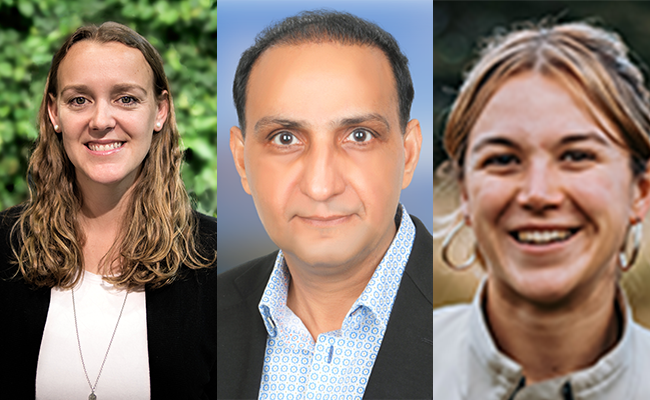
Nine Otago academics received just over $2 million in HRC funding designed to support early career researchers in establishing independent research careers.
Mothers worry about an exhaustive list of things; University of Otago researchers are hoping to help with one – is my baby getting enough breastmilk?
The University of Otago has been granted just over $2 million in the Emerging Researcher and Explorer Grants funding rounds, announced today.
Dr Lisa Daniels, Senior Research Fellow, in the Department of Medicine, will be using her almost $250,000 Emerging Researcher grant to determine how much milk a breastfeeding baby is actually receiving and how that compares to the mother's perception of supply.
“The first 1,000 days are the foundation for lifelong health and wellbeing. Although exclusive breastfeeding is recommended until around six months of age, relatively few mothers in New Zealand reach this milestone.
“Perceived insufficient milk supply is reported to be a leading cause of early cessation of breastfeeding, yet it is currently unknown whether the perception of insufficient milk supply is associated with actual low breast milk supply.”
The study will include 150 mothers who are breastfeeding their 3-month-old babies and who have differing perceptions of how much milk their baby is receiving.
“To the best of my knowledge this research will be the first using the gold standard stable isotope method to assess breast milk volumes - actual breast milk supply - and its association with maternal perception of breast milk supply,” Dr Daniels says.
Put simply, to assess actual breast milk supply, the mother will drink a set quantity of deuterium oxide (D2O) – more commonly known as heavy water. Saliva samples collected from both māmā and pēpi over a 14-day period will determine the amount of D2O consumed by the baby through breast milk, and therefore the amount of milk baby is receiving.
The study will not only be beneficial to health professionals working with breastfeeding mothers with milk supply concerns, if the results suggests that perception of milk supply is not related to actual milk volumes produced, it could have physical and mental health benefits for mothers.
“There are many stressors on a new mother, and reducing a concern about the ability to supply sufficient amounts of milk to her infant may contribute to improved mental health and wellbeing.
“Evidence also suggests that early breastfeeding cessation is associated with an increased risk of postpartum depression, and we know that continued breastfeeding reduces mothers' risk of breast and ovarian cancers and non-communicable diseases such as type-2-diabetes,” she says.

Grant recipients, from left to right, Dr Alice Hyun Min Kim, Dr Amber Young and Associate Professor Aniruddha Chatterjee
Dr Amber Young, of the School of Pharmacy, is also using her almost $250,000 Emerging Researcher grant to help protect hapu māmā and their pēpi, this time by identifying and developing interventions to overcome barriers to maternal immunisation and improve vaccination uptake.
“The safety and benefits of maternal immunisation are widely documented, yet maternal immunisation coverage in Aotearoa is suboptimal, with less than half of pregnant people being vaccinated against influenza (flu) and pertussis (whooping cough),” she says.
“There is also large variation across regions and ethnicities—hapū Māori are much less likely to receive maternal pertussis or influenza vaccination compared to other ethnicities. Further, whooping cough hospitalisations in the first year of life are about 2.5 times higher among Māori, mostly in the first three months of life when maternal immunisation is the only means of protection.
“However, immunisation coverage in Aotearoa is insufficient, with less than half of the pregnant population immunised. Furthermore, there are significant inequities in coverage, with wahine Māori having lower coverage rates than other ethnicities, putting Māori māmā and their pēpi at higher risk from vaccine-preventable diseases.”
Barriers to maternal immunisation include costs to access services, lack of transport, mistrust of health systems and lack of appropriate information, Dr Young says .
“The aims of this study are to identify and prioritise culturally appropriate interventions to improve understanding, access, and uptake of maternal vaccination among Māori hapū māmā.
“We will engage with key stakeholders in these localities including immunisation coordinators, midwives, GPs, pharmacists, Iwi healthcare providers, community representatives and hapu Māori to prioritise interventions to address the specific needs of Māori whānau to improve maternal immunisation coverage across Aotearoa.”
“Overall, this will identify culturally appropriate and relevant interventions for primary care in Aotearoa, with an emphasis on improving coverage in hapū Māori,” she says.
Implementing the adapted interventions and assess their ability to improve immunisation coverage in hapū wahine will be the next project.
Deputy-Vice-Chancellor (Research and Enterprise) Professor Richard Blaikie congratulated all of the recipients.
“It's wonderful to see researchers' hard work and innovative ideas recognised nationally in this manner.
“It's particularly pleasing to see Otago continue our strong showing in the Emerging Researcher category which highlights the high calibre of early-career staff at our University. I look forward to witnessing the contributions they will make to their fields.”

Grant recipients, from left to right, Dr Annie Wong, Associate Professor Christopher Brown and Dr Kathryn Hally.
Explorer grants
Associate Professor Christopher Brown
Department of Biochemistry
$150,000
There is an urgent need for replacements for antibiotics. During evolution bacterial viruses have evolved to manipulate or destroy specific human pathogens. There are huge and rapidly increasing numbers of sequences from bacterial viruses in the public domain, but this wealth of data has not been able to be fully utilised. We believe that it has now become possible to mine this data for new antibiotics. In preliminary studies we have identified thousands of potential anti-bacterials – the difficulty is choosing the best ones. To select these we propose to develop novel computer methods to predict their hosts, biophysical, functional, and expression properties. If successful, this research will provide proof of principle by discovering and testing pre-clinically new anti-bacterials. It will open up a novel and flexible computational approach to transform antibiotic discovery.
Associate Professor Aniruddha Chatterjee
Department of Pathology
$150,000
Although about 90% of cancer deaths are caused by metastasis, the underlying molecular events that drive it are poorly understood. This limited understanding hinders the development of effective cancer treatments. Initially thought to be driven by genetic mutations, our work indicates that epigenetic changes such as DNA methylation may be responsible for driving metastasis. Until recently it has not been possible to directly demonstrate that specific methylation changes alter metastatic potential. However, the development of precision editing tools now provides an opportunity to specifically edit epigenetic states target genes and to exclusively investigate the effect of these changes on cancer cell function. Our proposed research will further develop CRISPR/Cas technology to enable high-throughput interrogation of epigenetic drivers of metastasis. We aim to demonstrate that epigenetic mechanisms drive metastasis. This will open new avenues for understanding metastasis biology, lead to better outcome prediction, and identify new therapeutic targets to treat metastatic cancers.
Emerging researcher
Dr Annie Wong
Department of Medicine (UOW)
$249,999
Circulating tumour DNA in hastening the diagnosis of lung cancer
Lung cancer is New Zealand's top cancer research priority as it is the leading cause of cancer-related death and disproportionately disadvantages Māori and Pacific people. We aim to improve the diagnostic process of lung cancer by replacing invasive biopsies with a blood-based test of circulating tumour DNA (ctDNA). This study plans to prove the effectiveness of a customised blood test on patients with lung cancer with known gene mutations. Development of ctDNA technology will directly benefit patients by reducing diagnostic times from months to days and identifying patients who will benefit from life-saving targeted treatment. Establishing ctDNA research collaborations nationally and internationally will benefit lung cancer outcomes as well as other cancers such as colon, breast cancer and melanoma.
Dr Kathryn Hally
Department of Surgery and Anaesthesia (UOW)
$249,214
Harnessing the immune system for predicting adverse postoperative recovery
As the burden of surgery rises in Aotearoa NZ, so too will the incidence of postoperative morbidity and mortality. Despite its necessity, the act of surgery is associated with a profound immune response which can influence an individual's postoperative recovery. Here, we provide a framework for investigating the immune response to surgery as a functional biomarker for early detection of surgical patients at-risk of adverse postoperative recovery. This study will employ cutting-edge full-spectrum flow cytometry to interrogate the trajectory of the immune response to surgery in two distinct major surgeries (orthopaedic surgery and vascular surgery) and will utilize patient-centred tools for assessing postoperative recovery. Here, we present a streamlined workflow for immunological biomarker discovery for postoperative recovery, which may provide additive information for clinical decision-making in this context.
Dr Amber Young
School of Pharmacy
$249,998
Protecting hapū māmā and pēpi from vaccine preventable diseases
Maternal immunisation against pertussis and influenza protects hapu māmā and pēpi from infection and potentially fatal outcomes. The safety and efficacy of these vaccines are well documented. However, immunisation coverage in Aotearoa is insufficient, with less than half of the pregnant population immunised. Furthermore, there are significant inequities in coverage, with wahine Māori having lower coverage rates than other ethnicities, putting Māori māmā and their pēpi at higher risk from vaccine-preventable diseases. Barriers to maternal immunisation include costs to access services, mistrust of health systems and lack of appropriate information. We will identify and develop interventions to overcome these barriers and improve vaccination uptake for hapu māmā within localities that have significant inequities. We will engage with key stakeholders in these localities including immunisation coordinators, midwives, GPs, pharmacists, Iwi, and community representatives to prioritise interventions to address the specific needs of Māori whānau to improve maternal immunisation coverage across Aotearoa.

Grant recipients, from left to right, Dr Lisa Daniels, Dr Mak Sarwar and Dr Teodora Georgescu.
Dr Teodora Georgescu
Department of Anatomy
$250,000
Prolactin-mediated suppression of fever during pregnancy
The maternal brain undergoes numerous physiological adaptations that ultimately safeguard the healthy development of offspring. To protect the unborn foetus from exposure to elevated maternal body temperatures that are detrimental to development, the fever response is suppressed in women during pregnancy. However, the neuronal mechanism behind this vital adaptation is unknown. Prolactin levels are considerably increased during pregnancy, making prolactin-driven pathways a viable candidate for mediating this adaptation. We have identified prolactin receptor (Prlr)-expressing neurons present in two key brain regions for modulating the fever response: the raphe pallidus and the ventral medial preoptic area. By measuring and manipulating the activity of these Prlr-expressing cells during an infection, we propose to reveal how hormones act on neural circuits during pregnancy to attenuate the febrile response. These experiments will begin to assemble an avenue of novel research focused on maternal immune responses, thereby providing a framework to ensure a successful pregnancy.
Dr Alice Hyun Min Kim
Dean's Department (UOW)
$249,967
The effects of climate variability on the risk of enteric diseases
"Enteric disease is a common seasonal illness which disproportionately affect Māori and Pasifika. Its risk is expected to rise with climate change, and we need evidence specific for Aotearoa New Zealand.
We will conduct an epidemiological investigation of the most common enteric diseases and examine the effects of seasonal patterns and meteorological factors on hospital admission rates using time series analysis methods. We will explore methods for predicting risks based on long-term climate projections which will inform the methodology for future research.
The outcomes of this research will help inform areas to target for prevention strategies, forecast health risks and system requirement for responding to seasonal risks of enteric diseases. This study will also identify any differences in burden borne by Māori and Pasifika. The proposed study will advance knowledge, strengthen collaborative relationships, and build research capabilities for future research on climate change and health outcomes."
Dr Mak Sarwar
Department of Obstetrics & Gynaecology (UoC)
$249,959
Novel targeted therapeutic strategy for ovarian cancer treatment
Ovarian cancer is the 5th leading cause of death in New Zealand women with a mortality rate of over 60% which is the highest among gynaecological cancers. Nearly all ovarian cancer patients face a traumatizing and incurable phase. Cancer cells adapt various mechanisms to overcome drug-induced toxicity. By targeting these mechanisms, we may be able to develop novel therapies for ovarian cancers that would otherwise be unlikely to respond to the standard treatment. Our preliminary work provided some evidence indicating the therapeutic value of the multi-targeting approach in ovarian cancer. In addition, the proposed study also involves the development and investigation of novel drug combinations and drug delivery system capable of multitargeting and delivering drugs specifically at the tumour site. The findings will help to explore better and alternative treatments for clinically challenging ovarian cancer, where the goals are currently the palliation of symptoms, thus improving the health and wellbeing.
Dr Lisa Daniels
Department of Medicine
$249,454
Maternal perception vs actual breast milk supply: is there a difference?
The first 1,000 days are the foundation for lifelong health and wellbeing. Although exclusive breastfeeding is recommended until around six months of age, relatively few mothers in New Zealand reach this milestone. Perceived insufficient milk supply is reported to be a leading cause of early cessation of breastfeeding, yet it is currently unknown whether the perception of insufficient milk supply is associated with actual low breast milk supply. This study will recruit 150 mother-pēpi dyads and determine actual breast milk intakes of three-month old infants (using gold standard stable isotope methods). This will allow us to determine whether breast milk volumes produced are associated with the perception of breast milk supply. The results will be beneficial to health professionals working with lactating mothers with milk supply concerns.